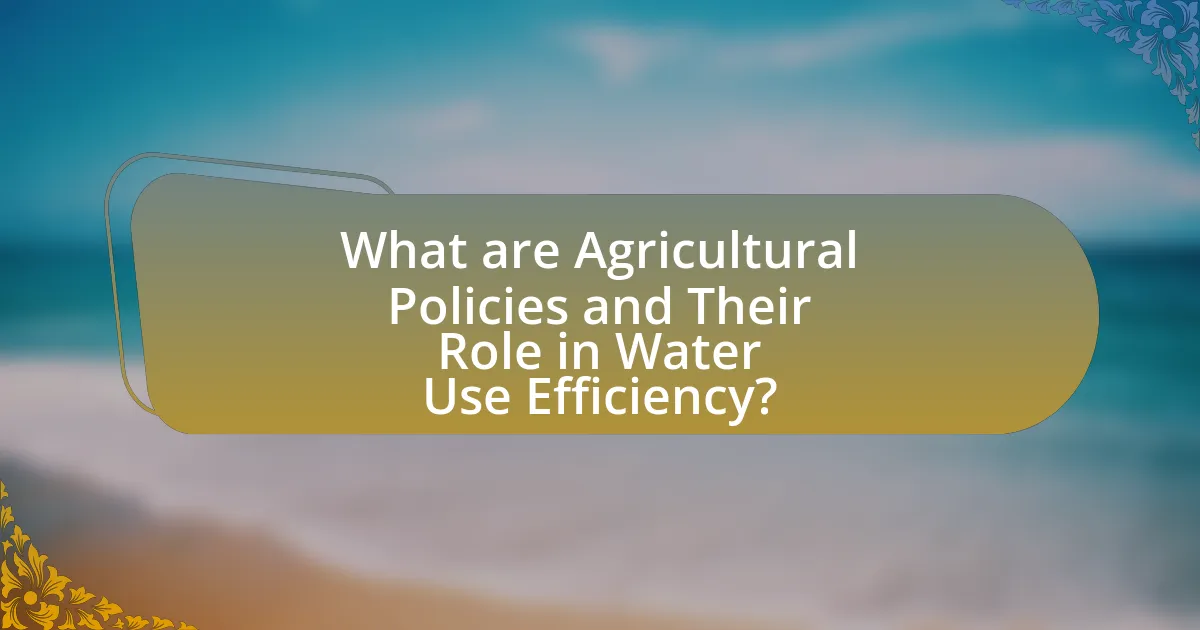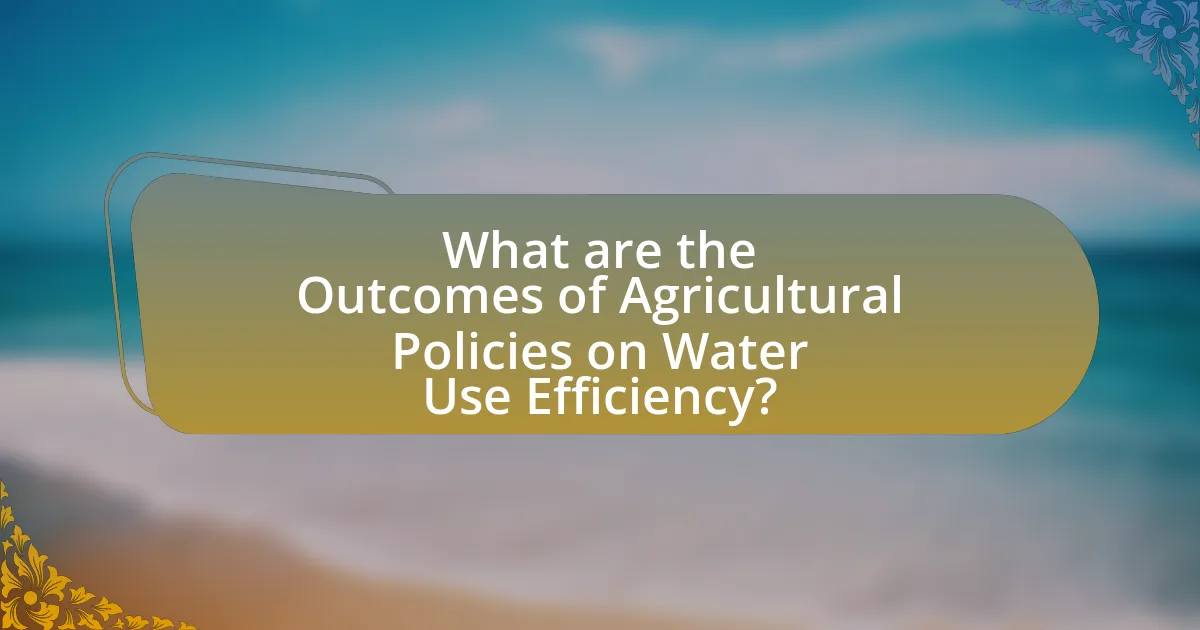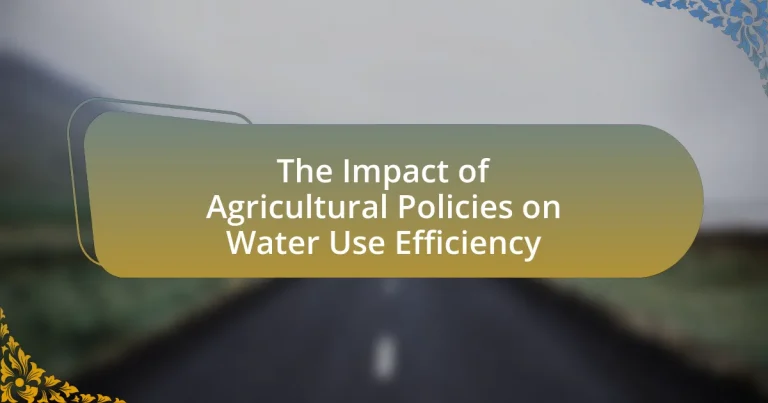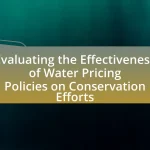Agricultural policies are essential regulations established by governments to manage farming practices, particularly in relation to water use efficiency. These policies promote sustainable practices, incentivize technology adoption, and regulate water allocation, significantly impacting agricultural productivity and environmental sustainability. Key strategies include the implementation of water pricing mechanisms, investment in advanced irrigation technologies, and the promotion of conservation practices. The article explores how these policies vary across regions, their influence on water management practices, and the economic implications of improved water use efficiency, highlighting the critical role of effective water management in addressing food security and environmental challenges.

What are Agricultural Policies and Their Role in Water Use Efficiency?
Agricultural policies are regulations and guidelines established by governments to manage agricultural practices, including water use. These policies play a crucial role in enhancing water use efficiency by promoting sustainable practices, incentivizing technology adoption, and regulating water allocation. For instance, policies that encourage drip irrigation or rainwater harvesting can significantly reduce water wastage, leading to more efficient agricultural production. According to the Food and Agriculture Organization, implementing efficient irrigation practices can increase water productivity by up to 50%, demonstrating the effectiveness of targeted agricultural policies in optimizing water resources.
How do agricultural policies influence water management practices?
Agricultural policies significantly influence water management practices by establishing regulations and incentives that dictate water usage in farming. For instance, policies that promote water-efficient irrigation technologies encourage farmers to adopt practices that reduce water consumption, thereby enhancing water use efficiency. A study by the Food and Agriculture Organization (FAO) highlights that countries implementing water-saving agricultural policies have seen a reduction in water usage by up to 30% in certain crops. Additionally, subsidies for drought-resistant crops can lead to shifts in planting decisions, further impacting water management strategies. These policies create a framework that not only guides farmers in their water usage but also aligns agricultural practices with sustainable water resource management.
What specific policies are implemented to enhance water use efficiency?
Specific policies implemented to enhance water use efficiency include the adoption of water pricing mechanisms, investment in irrigation technology, and the promotion of sustainable agricultural practices. Water pricing mechanisms incentivize users to conserve water by reflecting the true cost of water supply, thereby encouraging efficient usage. Investment in advanced irrigation technologies, such as drip and sprinkler systems, significantly reduces water wastage and improves crop yields. Additionally, promoting sustainable agricultural practices, such as crop rotation and soil moisture management, further enhances water efficiency by optimizing water use in farming operations. These policies are supported by various studies, including the Food and Agriculture Organization’s report on water management, which highlights the effectiveness of these strategies in improving water use efficiency in agriculture.
How do these policies vary across different regions?
Agricultural policies vary significantly across different regions, primarily due to local climate conditions, water availability, and economic priorities. For instance, in arid regions like the Middle East, policies often emphasize water conservation techniques and the use of advanced irrigation technologies to maximize efficiency. In contrast, regions with abundant water resources, such as parts of the Midwest in the United States, may focus more on crop yield optimization rather than strict water use regulations. Additionally, European Union policies promote sustainable practices through regulations that encourage reduced water usage and environmental protection, reflecting a commitment to sustainability. These variations are supported by regional studies, such as the Food and Agriculture Organization’s reports, which highlight how local conditions shape policy frameworks and their effectiveness in enhancing water use efficiency.
Why is water use efficiency critical in agriculture?
Water use efficiency is critical in agriculture because it maximizes crop yield while minimizing water consumption. Efficient water use directly impacts food production, especially in regions facing water scarcity, where agriculture accounts for approximately 70% of freshwater withdrawals globally. By implementing practices that enhance water use efficiency, such as drip irrigation and rainwater harvesting, farmers can reduce water waste and improve sustainability. Studies indicate that improving water use efficiency can increase agricultural productivity by up to 50%, thereby supporting food security and economic stability in farming communities.
What are the environmental impacts of inefficient water use?
Inefficient water use leads to significant environmental impacts, including habitat degradation, reduced biodiversity, and increased soil salinity. When water is mismanaged, ecosystems suffer as aquatic habitats dry up, affecting species that rely on these environments. For instance, over-extraction of water for irrigation can lower water tables, resulting in the loss of wetlands, which are crucial for many plant and animal species. Additionally, inefficient irrigation practices can lead to salinization of soil, diminishing agricultural productivity and harming surrounding ecosystems. According to the Food and Agriculture Organization, approximately 20% of irrigated land suffers from salinity issues, which can severely impact crop yields and local biodiversity.
How does water use efficiency affect agricultural productivity?
Water use efficiency directly enhances agricultural productivity by maximizing crop yield per unit of water consumed. Efficient water use allows farmers to irrigate crops more effectively, leading to better growth conditions and higher yields. For instance, studies have shown that improving water use efficiency can increase crop yields by 20-50%, depending on the crop type and environmental conditions. This increase is crucial in regions facing water scarcity, where optimizing water resources can significantly impact food security and economic stability.

What are the Key Agricultural Policies Affecting Water Use Efficiency?
Key agricultural policies affecting water use efficiency include the implementation of water pricing mechanisms, irrigation efficiency standards, and conservation programs. Water pricing mechanisms incentivize farmers to use water more judiciously by reflecting the true cost of water supply, which can lead to reduced consumption and improved efficiency. For instance, countries like Australia have adopted tiered pricing structures that encourage conservation. Irrigation efficiency standards mandate the adoption of advanced irrigation technologies, such as drip irrigation, which can significantly reduce water waste. Additionally, conservation programs, often supported by government subsidies, promote practices like crop rotation and soil moisture management, further enhancing water use efficiency. These policies collectively aim to optimize water resources in agriculture, addressing both economic and environmental sustainability.
How do irrigation policies impact water use efficiency?
Irrigation policies significantly impact water use efficiency by establishing guidelines that dictate how water resources are allocated and utilized in agricultural practices. These policies can promote the adoption of advanced irrigation technologies, such as drip and sprinkler systems, which enhance water delivery and minimize waste. For instance, regions implementing strict water allocation policies often see improved efficiency metrics; studies indicate that areas with regulated irrigation practices can achieve up to 30% higher water use efficiency compared to those without such regulations. Furthermore, policies that incentivize water conservation practices encourage farmers to adopt sustainable methods, leading to reduced water consumption and improved crop yields.
What types of irrigation policies are most effective?
Effective irrigation policies include water pricing, regulatory frameworks, and investment in technology. Water pricing encourages efficient water use by reflecting the true cost of water, which has been shown to reduce consumption and promote conservation. Regulatory frameworks, such as water rights allocation and usage restrictions, help manage water resources sustainably, ensuring equitable distribution among users. Investment in technology, such as drip irrigation and soil moisture sensors, enhances water use efficiency, leading to higher crop yields with less water. Studies indicate that regions implementing these policies have experienced significant improvements in water use efficiency, demonstrating their effectiveness in agricultural practices.
How do subsidies influence irrigation practices?
Subsidies significantly influence irrigation practices by incentivizing farmers to adopt more efficient water use technologies and methods. For instance, financial support for drip irrigation systems encourages farmers to transition from traditional flood irrigation, which is often wasteful, to more precise watering techniques that conserve water. A study by the Food and Agriculture Organization (FAO) indicates that countries providing subsidies for modern irrigation technologies have seen a 20-30% increase in water use efficiency. This demonstrates that targeted financial assistance can lead to improved agricultural productivity while promoting sustainable water management practices.
What role do conservation policies play in water management?
Conservation policies play a critical role in water management by promoting sustainable practices that enhance water use efficiency in agriculture. These policies often include regulations and incentives aimed at reducing water waste, protecting water quality, and encouraging the adoption of technologies that optimize water usage. For instance, the implementation of policies such as the U.S. Environmental Protection Agency’s WaterSense program has led to significant reductions in water consumption by promoting water-efficient products and practices, resulting in billions of gallons saved annually. Additionally, conservation policies can facilitate the development of water management plans that prioritize the allocation of water resources, ensuring that agricultural needs are met while preserving ecosystems.
How do conservation policies promote sustainable water use?
Conservation policies promote sustainable water use by implementing regulations and incentives that encourage efficient water management practices. These policies often include measures such as water pricing, restrictions on water usage during droughts, and support for technologies that enhance irrigation efficiency. For instance, the implementation of tiered water pricing can motivate agricultural producers to reduce water consumption, as higher usage leads to increased costs. Additionally, policies that promote the adoption of drip irrigation systems have been shown to reduce water usage by up to 50% compared to traditional methods, thereby conserving water resources while maintaining agricultural productivity.
What are the challenges in implementing conservation policies?
The challenges in implementing conservation policies include insufficient funding, lack of stakeholder engagement, and regulatory complexities. Insufficient funding limits the resources available for effective policy execution, making it difficult to achieve conservation goals. Lack of stakeholder engagement often results in resistance from local communities and agricultural producers, who may feel their needs are not being considered. Regulatory complexities can create barriers to implementation, as navigating various laws and regulations can be cumbersome and time-consuming. These challenges hinder the effectiveness of conservation policies aimed at improving water use efficiency in agriculture.

What are the Outcomes of Agricultural Policies on Water Use Efficiency?
Agricultural policies significantly enhance water use efficiency by promoting sustainable practices and technologies. These policies often include incentives for adopting efficient irrigation systems, such as drip or sprinkler irrigation, which can reduce water consumption by up to 50% compared to traditional methods. Additionally, regulations that encourage crop selection based on water availability lead to more efficient water use, as seen in regions where drought-resistant crops are prioritized. Studies indicate that countries implementing comprehensive agricultural policies experience improved water management, resulting in increased agricultural productivity while conserving water resources. For instance, the implementation of the European Union’s Common Agricultural Policy has led to better water management practices across member states, demonstrating a clear link between policy frameworks and enhanced water use efficiency.
How do agricultural policies affect water consumption rates?
Agricultural policies significantly influence water consumption rates by determining water allocation, pricing, and usage practices. For instance, policies that promote water-efficient irrigation techniques can lead to reduced water usage in agriculture. According to a study by the Food and Agriculture Organization, implementing policies that encourage drip irrigation can decrease water consumption by up to 30% compared to traditional methods. Additionally, subsidies for water-saving technologies incentivize farmers to adopt practices that lower overall water demand, thereby impacting regional water consumption rates.
What trends have been observed in water consumption due to policy changes?
Trends in water consumption due to policy changes indicate a significant reduction in usage in regions implementing stricter regulations. For instance, policies promoting water-efficient irrigation techniques have led to a 20-30% decrease in agricultural water use in areas like California, as reported by the California Department of Water Resources. Additionally, the introduction of tiered water pricing has incentivized conservation, resulting in a 15% reduction in urban water consumption in cities such as San Diego. These trends demonstrate that effective policy measures can lead to substantial improvements in water use efficiency.
How do these outcomes vary by crop type?
Outcomes related to water use efficiency vary significantly by crop type due to differing water requirements and growth characteristics. For instance, high-water-demand crops like rice and sugarcane typically exhibit lower water use efficiency compared to drought-resistant crops such as sorghum and millet, which require less water to achieve similar yields. Research indicates that rice can consume up to 5,000 liters of water per kilogram of yield, while sorghum may only require around 1,200 liters per kilogram, demonstrating a stark contrast in water efficiency. Additionally, policies promoting water-saving technologies tend to benefit crops that are already more efficient, further widening the gap in outcomes based on crop type.
What are the economic implications of improved water use efficiency?
Improved water use efficiency leads to significant economic benefits, including increased agricultural productivity and reduced costs for farmers. By utilizing water more effectively, crops can yield higher outputs per unit of water consumed, which enhances food security and boosts farmers’ incomes. For instance, a study by the Food and Agriculture Organization (FAO) indicates that improving irrigation efficiency can increase crop yields by up to 50%, thereby directly impacting the economic viability of agricultural operations. Additionally, reduced water usage lowers the costs associated with water extraction and treatment, further enhancing profitability for agricultural producers. Overall, these economic implications underscore the importance of efficient water management in agriculture, contributing to sustainable development and economic resilience in farming communities.
How does water use efficiency contribute to cost savings for farmers?
Water use efficiency directly contributes to cost savings for farmers by reducing the amount of water needed for irrigation, which lowers water bills and operational costs. Efficient water use practices, such as drip irrigation and soil moisture monitoring, can lead to a reduction in water consumption by up to 30-50%, as reported by the Food and Agriculture Organization. This decrease in water usage not only minimizes expenses related to water procurement but also enhances crop yields, allowing farmers to maximize their profits while using fewer resources.
What are the broader economic benefits for communities?
Broader economic benefits for communities include increased agricultural productivity, job creation, and enhanced local economies. Efficient water use, driven by agricultural policies, leads to higher crop yields, which can boost farmers’ incomes and stimulate local markets. For instance, a study by the Food and Agriculture Organization indicates that improved water management can increase agricultural output by up to 30%, directly benefiting community livelihoods. Additionally, these policies can attract investments in infrastructure and technology, further supporting economic growth and sustainability within the community.
What best practices can be adopted to enhance water use efficiency?
To enhance water use efficiency, adopting practices such as precision irrigation, rainwater harvesting, and crop selection based on drought resistance is essential. Precision irrigation techniques, like drip irrigation, deliver water directly to the plant roots, reducing evaporation and runoff, which can improve water use efficiency by up to 90% compared to traditional methods. Rainwater harvesting systems can capture and store rainwater for agricultural use, providing an alternative water source and reducing dependency on groundwater. Additionally, selecting drought-resistant crop varieties can significantly lower water requirements, as these crops are adapted to thrive in low-water conditions, thereby optimizing water usage in agriculture.
How can farmers implement effective water management strategies?
Farmers can implement effective water management strategies by adopting practices such as drip irrigation, rainwater harvesting, and soil moisture monitoring. Drip irrigation delivers water directly to the plant roots, reducing evaporation and runoff, which can increase water use efficiency by up to 90% compared to traditional methods. Rainwater harvesting allows farmers to collect and store rainwater for irrigation, providing an alternative water source during dry periods. Soil moisture monitoring helps farmers determine the optimal time for irrigation, preventing overwatering and conserving water resources. These strategies are supported by research indicating that efficient water management can significantly enhance crop yields while minimizing water usage, aligning with agricultural policies aimed at improving water use efficiency.
What role does technology play in improving water use efficiency?
Technology plays a crucial role in improving water use efficiency by enabling precise monitoring and management of water resources. Advanced irrigation systems, such as drip and sprinkler technologies, deliver water directly to plant roots, minimizing waste and evaporation. Additionally, sensors and data analytics allow farmers to assess soil moisture levels and weather conditions, optimizing irrigation schedules. For instance, the use of soil moisture sensors can reduce water usage by up to 30% while maintaining crop yields. Furthermore, technologies like remote sensing and satellite imagery provide insights into water distribution and crop health, facilitating better decision-making. These innovations collectively enhance water conservation efforts and promote sustainable agricultural practices.


